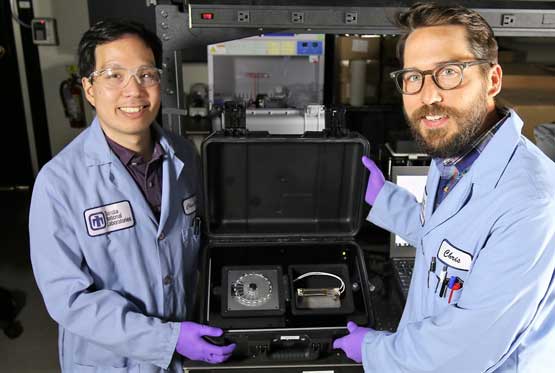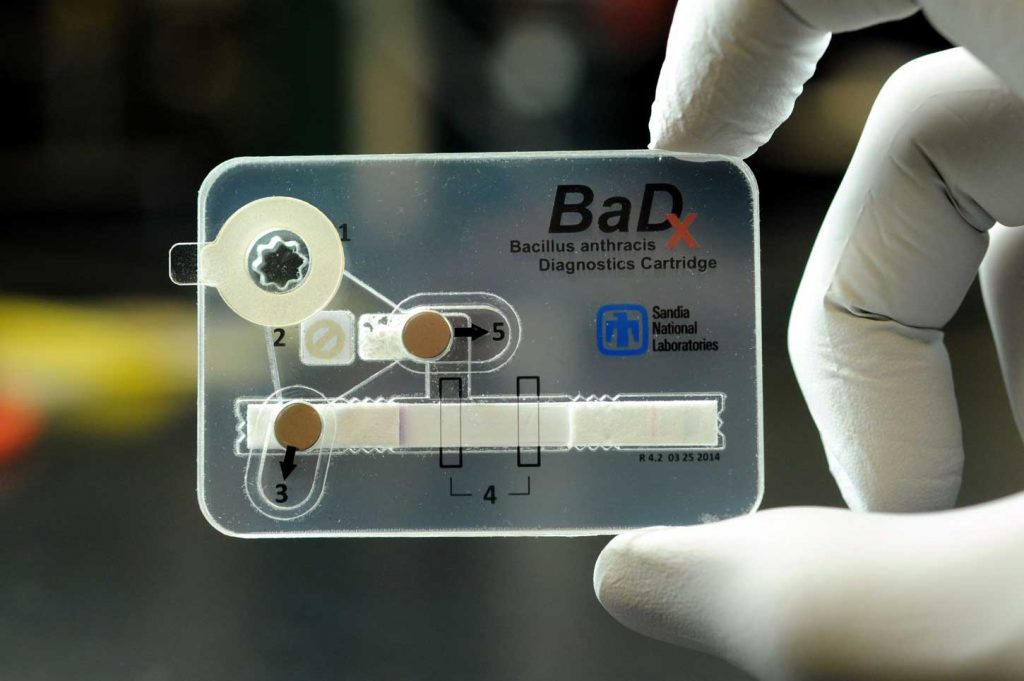
A clear September morning 20 years ago changed everyone. It also fundamentally changed Sandia, creating new priorities for the Labs and giving it a new role in service to the nation.
Then-NNSA Administrator John Gordon called Sandia less than an hour after terrorists slammed American Airlines Flight 11 into the World Trade Center at 6:46 a.m. Mountain time. He needed Sandia’s expertise about an until-then theoretical scenario the Labs had first studied in the 1980s: a fully fueled aircraft crashing into a building. This first call, on a day no American who lived through it will forget, was just a precursor to a pattern that would emerge in the years following September 11, 2001 — the nation needed Sandia’s expertise to confront a growing list of threats to the American people.
Department of Homeland Security is born
One of the first priorities of the George W. Bush administration was starting up the Department of Homeland Security. Sandians were called upon to help establish the framework of a new cabinet-level organization that would encompass border operations, immigration and 20 other security agencies, including a Science and Technology Directorate.
Holly Dockery, current director of Global Security Program Management, was leading Russian Cooperative Threat Reduction Programs in 2001 and was one of the Sandians called to serve on the White House Transition Planning Office, which stood up DHS and its component agencies.
“We worked almost 24/7 for 8 months to get ready,” Holly recalled. “The Transition Planning Office team was asked to stay on after the legislation was passed in March [2002] to create the Department. It was truly like being part of a start-up. You had to be prepared to do a little bit of everything. Sandian John Cummings led what we now know as the Critical Infrastructure Protection efforts, leveraging DOE’s investment in National Infrastructure Simulation and Analysis Center by modeling interdependencies. John Vitko headed the bio effort. It was his leadership that resulted in the first U.S. strategy to counter bioterror. He was recognized with a DHS Secretary’s award for his work.”
John became the first Director of Biological and Chemical Countermeasures in the Science and Technology directorate and is still helping guide the Labs as a member of the External Advisory Board for Sandia’s Energy and Homeland Security portfolio.
In fact, throughout the 19-year history of DHS, Sandians were involved in the establishment of the Transportation Security Administration, the Countering Weapons of Mass Destruction Office and, in 2018, the Cybersecurity and Infrastructure Security Agency, as well as the reconstitution of FEMA within Homeland Security.
Radiological and biological scanners used at airports, ports and borders seem ubiquitous now, but in the early 2000s, in response to the terrorist attacks, Sandia had to figure out how to rethink detectors we had developed for many years. Most devices at that time were large, expensive, immobile and used at high-priority locations such as military bases. In response to the new demands for radiation detectors in civilian locations, Sandia began exploring solutions, and eventually developed more portable detectors that now are commonplace.
Bio expertise put to work

In the first week following September 11, another terrorist attack in Washington, D.C., drew Sandia into action. Letters containing anthrax spores were sent to several newsrooms and the offices of U.S. Senators Tom Daschle and Patrick Leahy, killing five and infecting 17 others.
A foam developed at Sandia was deployed to decontaminate Congressional offices and to kill the spores. Once again, research done years earlier came to the fore in the nascent focus on combating biological threats at home.
Following the Homeland Security Act of 2002, which established DHS, Sandia received its first funding from the National Institutes of Health to develop a portable diagnostic tool that could diagnose disease from human saliva. That project was based on work begun in the 1990s on the microChemLab project, which laid the groundwork for Sandia’s development of microfluidic technologies and hand-portable chemical and biological sensors.
This early work helped Sandia establish a track record in medical diagnostics that includes SpinDx, a lab-on-a-disk tool that can determine a patient’s white blood cell count, analyze important protein markers, and process up to 64 assays from a single sample, all in a matter of minutes. Sandia also invented BaDx, an anthrax detector that works without power, refrigerated storage or laboratory equipment to make testing safer, easier, faster and cheaper for more resource-constrained parts of the world.
The inventions have helped the nation reduce biological threats. The Secretary of Energy thanked more than 60 Sandians in 2017 for their work as part of a Technology Convergence Working Group that analyzed a blood sample transport system, from treatment units to diagnostic labs, in the African nation of Liberia during the Ebola outbreak of 2014. That group made recommendations to improve turnaround time in the blood analyses needed to combat the epidemic. And in 2020, the bio expertise of Sandians was used to combat the COVID-19 pandemic.
Data modeling, cybersecurity help combat emerging threats
High-performance computing and modeling are part of Sandia’s DNA. From the Sandia Analysis Workbench to Quantum Scientific Computing Open User Testbed, Sandia has a long history of creating digital architectures to analyze large amounts of data. The National Infrastructure Simulation and Analysis Center, a program jointly executed by Sandia and Los Alamos National Laboratory, became the core modeling and simulation capabilities for DHS after September 11.
Starting in 2004, Sandians were brought in to help support BioWatch, a DHS early warning system designed to detect trace amounts of biological materials in urban areas across the United States. Sandia’s modeling and analysis capabilities were tapped to site detectors in facilities and special events and as reachback to assist public health experts to determine the presence and geographic extent of a biological agent release in a facility. This information, provided within two hours of detection, allows federal, state and local officials to quickly determine emergency response, medical care and consequence management needs.
Sandia’s cybersecurity capabilities have also been called upon time after time to confront and deter burgeoning cyberattacks on American assets.
“In the decade following September 11, Sandia’s homeland security activities centered on anticipating and countering nuclear, radiological and physical security threats stemming from terrorism and nonstate actors at our nation’s borders,” said Associate Labs Director Andy McIlroy, head of Integrated Security Solutions and Sandia’s Energy and Homeland Security portfolio. “However, the most recent evolution in this space has been a shift to the cyber arena.
“The other threats have not gone away,” he said, “but cyberthreats to our homeland from both nation-states and nonstate actors — some of which are connected to organized crime — have increased in number and importance. The work in our Energy and Homeland Security mission portfolio shows how Sandia has risen to this challenge of turning our focus in homeland security to defending our cyberspace from organizations with fairly deep resources.”
Staying prepared to help the nation
The September 11 attacks and the accompanying loss of 2,996 American lives forever changed the balance of the work done at the Labs. It altered how it does work and increased the number of U.S. agencies it works with.
“Bringing the fight to the homeland made us think about security in a different way,” Holly said. “After 9/11 and the subsequent anthrax attacks, everyone in the U.S. and around the world wanted to pitch in and help make Homeland Security work.”
That work continues to evolve as Sandia’s Energy and Homeland Security mission portfolio focuses on securing the nation’s critical infrastructures, and responding to changing tactics from international adversaries and existential threats to national security posed by climate change, she said.
For more than 70 years, Sandia’s very existence has been part of the deterrent that has kept the world from nuclear war, Holly said. “We are the Laboratories that the U.S. government turns to first to solve the toughest and most urgent technical challenges, something that has remained unchanged before and after those terrorist attacks,” she said.
Former Labs Director Tom Hunter perhaps said it best when he characterized Sandia’s impact on national security.
“Deterrence is much broader than nuclear weapons … our adversaries understand that places like Sandia exist and that people like Sandians are working overtime to foil their plans,” he said. “Basically, our role is to deter them and outsmart them and to ensure that there is never a technological surprise we’re not ready to respond to.”